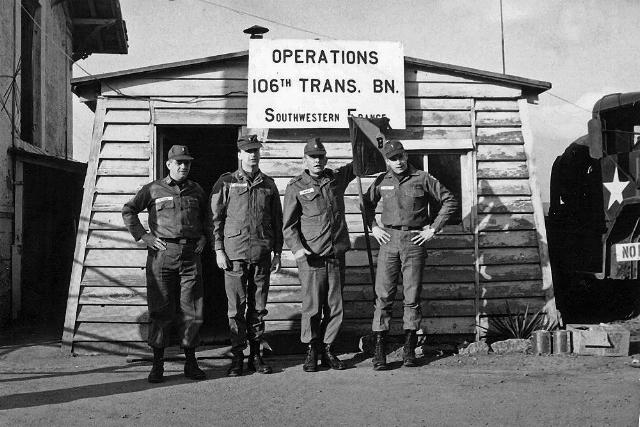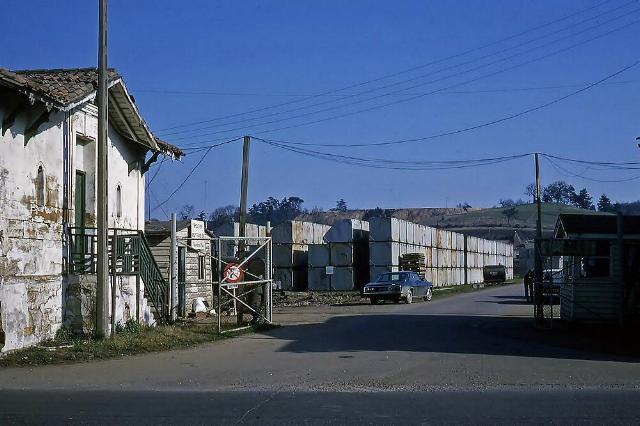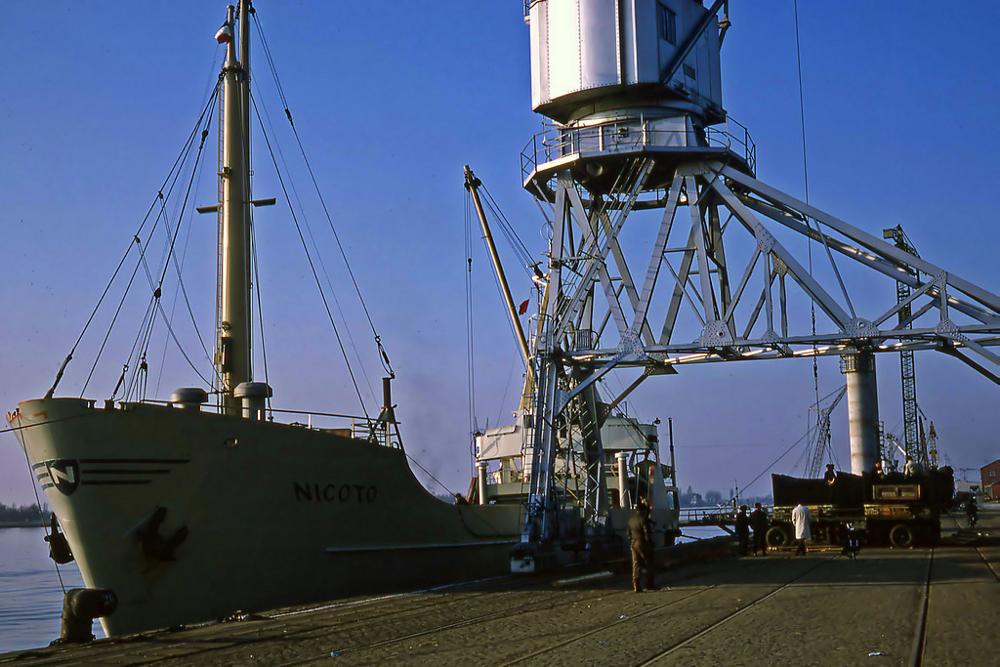
This is the stagging area for the cargo that had to be hauled out of Bussac

One of the cargo ships being loaded to move some of the cargo to Great Britian

Considering the response he was given to be unsatisfactory, de Gaulle started pursuing an independent defence for his country. France withdrew its Mediterranean fleet from NATO command on March 11, 1959, and pursued an independent nuclear program, theorizing the "Force de frappe" (Striking Force) meant for deterrence. In June 1959, de Gaulle banned the stationing of foreign nuclear weapons on French soil, which caused the United States to transfer 200 military aircraft out of France. Henceforth, the 26th Tactical Reconnaissance Wing stationed in Toul-Rosi�res Air Base was relocated to Ramstein AB in Germany
Causes for these moves can be traced back to some diplomatic history. The 1960s was a time of tension within the Atlantic Alliance. The United States and France were at loggerheads over America's leadership within NATO and America's growing involvement in Vietnam, a former French colony. President Charles de Gaulle flexed his muscles in April 1966 by pulling France out of the NATO integrated military command structure and ordering the United States and NATO to remove all troops and headquarters from French soil by March 31, 1967.
In private, U.S. President Lyndon B. Johnson "stretched his considerable talent for colorful language," recalled the U.S. Ambassador to NATO. Johnson churlishly instructed his Secretary of State to ask if de Gaulle wanted the United States to move American cemeteries out of France as well. (The government of France said no.) In public, Johnson remained calm, declaring: "When a man asks you to leave his house, you don't argue; you get your hat and go." With less than 12 months to go, EUCOM and its service components planned and executed the movement of numerous units and headquarters, 70,000 people (including family members) and 813,000 tons of materiel. The operation was named FRELOC, short for "Fast Relocation."
In 1965, General de Gaulle and France made the historic decision to
leave the military arm of NATO. This meant, of course, that US Forces
had to leave French soil. The decision was made, not only to withdraw US
Forces, but also to clear all US depots in France. The deadline was set
at 31 March 1967.
The 106th Trans Bn during Freloc
In April 1966, LTC Wanek was given the mission to clear the depots in western France. The initial concept of operation was for the 106th to clear depots in the general vicinity of Orleans and line-haul to Toul in the vicinity of Nancy. The code name for the operation vas FRELOC: an acronym for French Line of Comminations. However, the initial tonnage figures were seriously underestimated. FRELOC grew geometrically into an all-consuming monster of men and equipment. During the height of FRELOC, the l06th ironically found itself clearing it's original home in France: Bussac General Depot.
To appreciate the enormity of the mission, one must remember that the battalion retained responsibility for the Bremerhaven-Giessen line of communication. Even though much of it was deployed in France for 10 months, the battalion headquarters officially remained in Bremerhaven. Thus, the 106th was responsible for an extra- ordinarily extended line of communication, stretching from the North Sea port of Bremerhaven to Captieux, near the Atlantic Ocean port of Bordeaux. There is no way of knowing whether or not any U.S. Army Battalion ever had such a line of communication. There certainly can't have been very many.
Like the men of Tennyson' s brigade, the 106th didn't waste time or effort worrying about the problems; they simply rolled up their sleeves and got the job done. The cost was high. Three companies, the 70th, 77th and 598th, were heavily committed to FRELOC for the entire 10 months operation. Equipment availability was a constant, almost insurmountable, problem. The problem was exacerbated by the depot' s daytime only duty hours. Initially, the 106th hauled loaded trailers during the day and spotted empties during the evening. This meant that trailers stood idle at the depots' docks all night. The equipment problem became so critical that LTC Wanek. reversed the duty day. Empties were spotted the first. thing in the morning for loading. The drivers had "Reveille at Sundown" and hauled all night.
The 106th operated out of South West France, clearing the depot at Bussac, and surrounding U S Military facilities including La Rochelle. This is the 106th Staff (Det B )in Bussac in early 1967.



This innovation may have saved the entire operation. It certainly
enabled the 37th Group to have assets available for missions other than
FRELOC. During FRELOC, the battalion accumulated over 6.5 million miles.
Because of it's distinguished accomplishments during FRELOC, the l06th
was given the honor of pulling the last trailer out of France. In
keeping with it's tradition, the l06th accomplished the mission on time
and in good order. The last tractor was driven across the border by SP5
Wilson, 77th Transportation Company, with LT Hefferran as shotgun,
during 'the late evening of' 31 March 1967.
 E Mail if you have added information.
E Mail if you have added information.